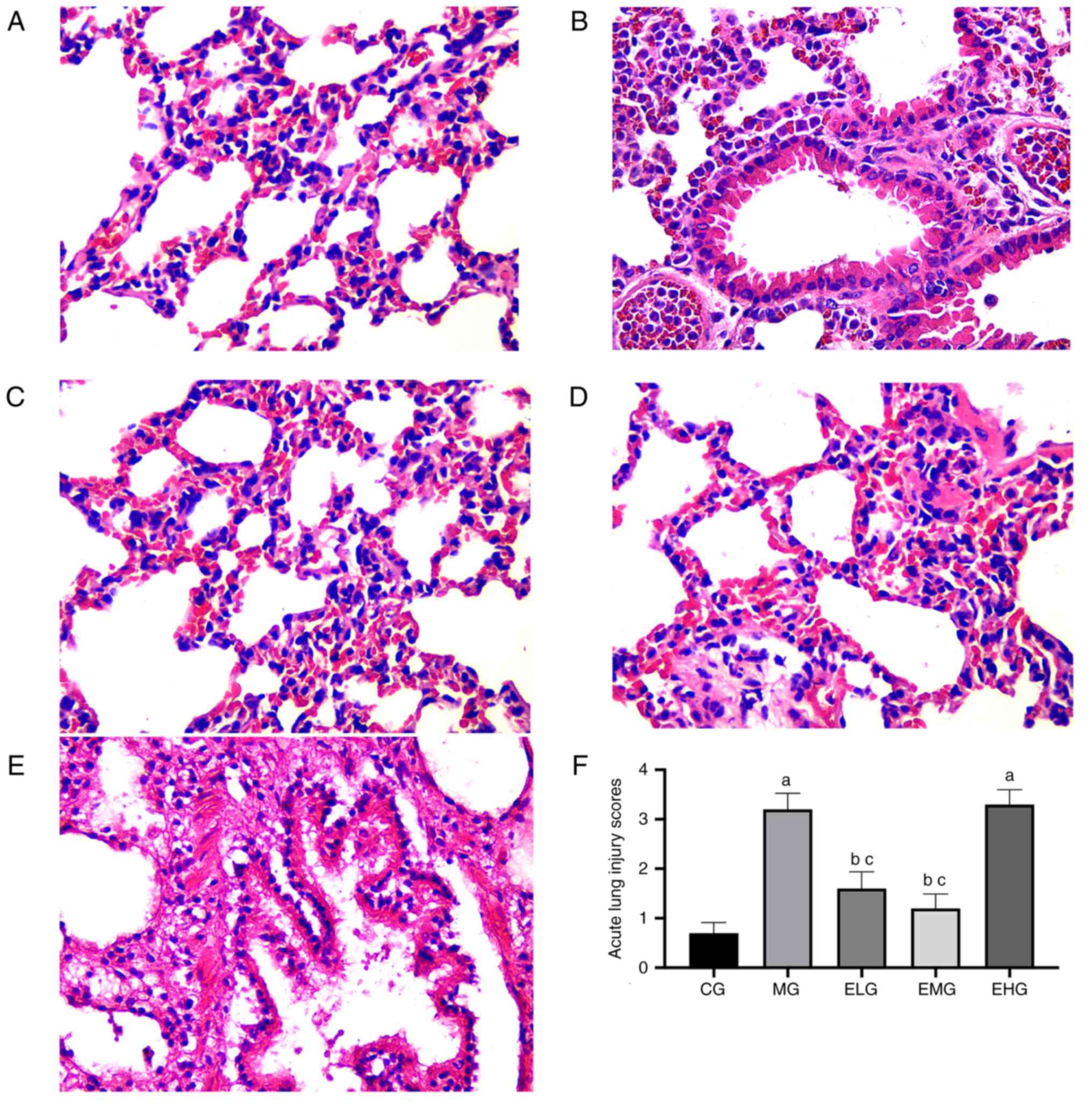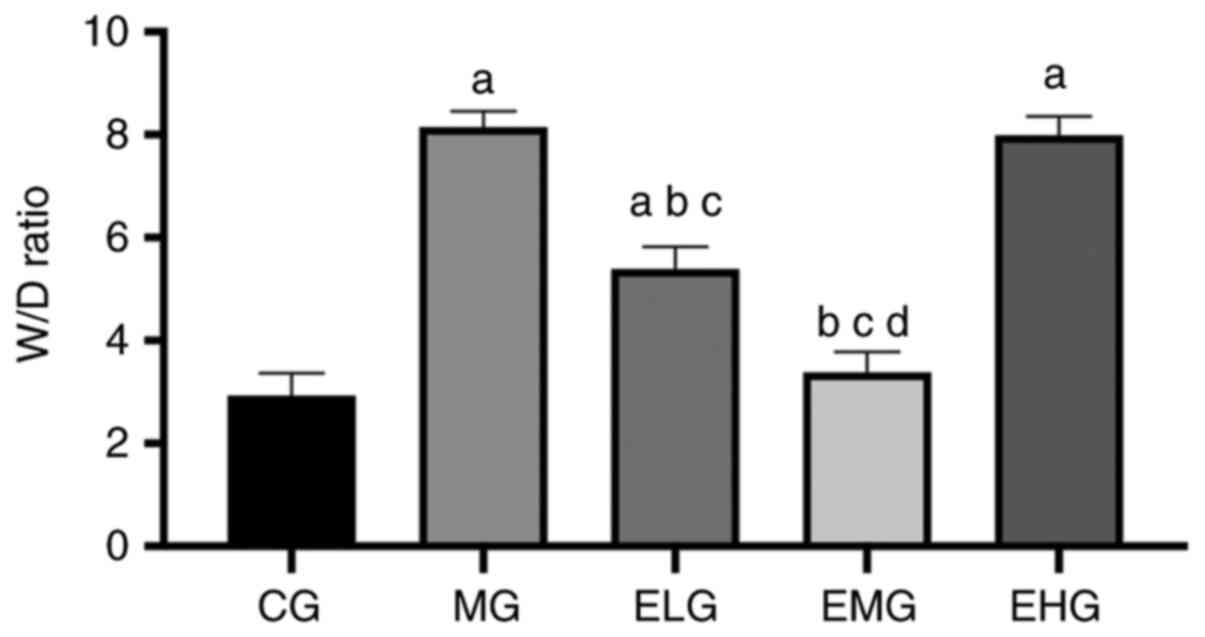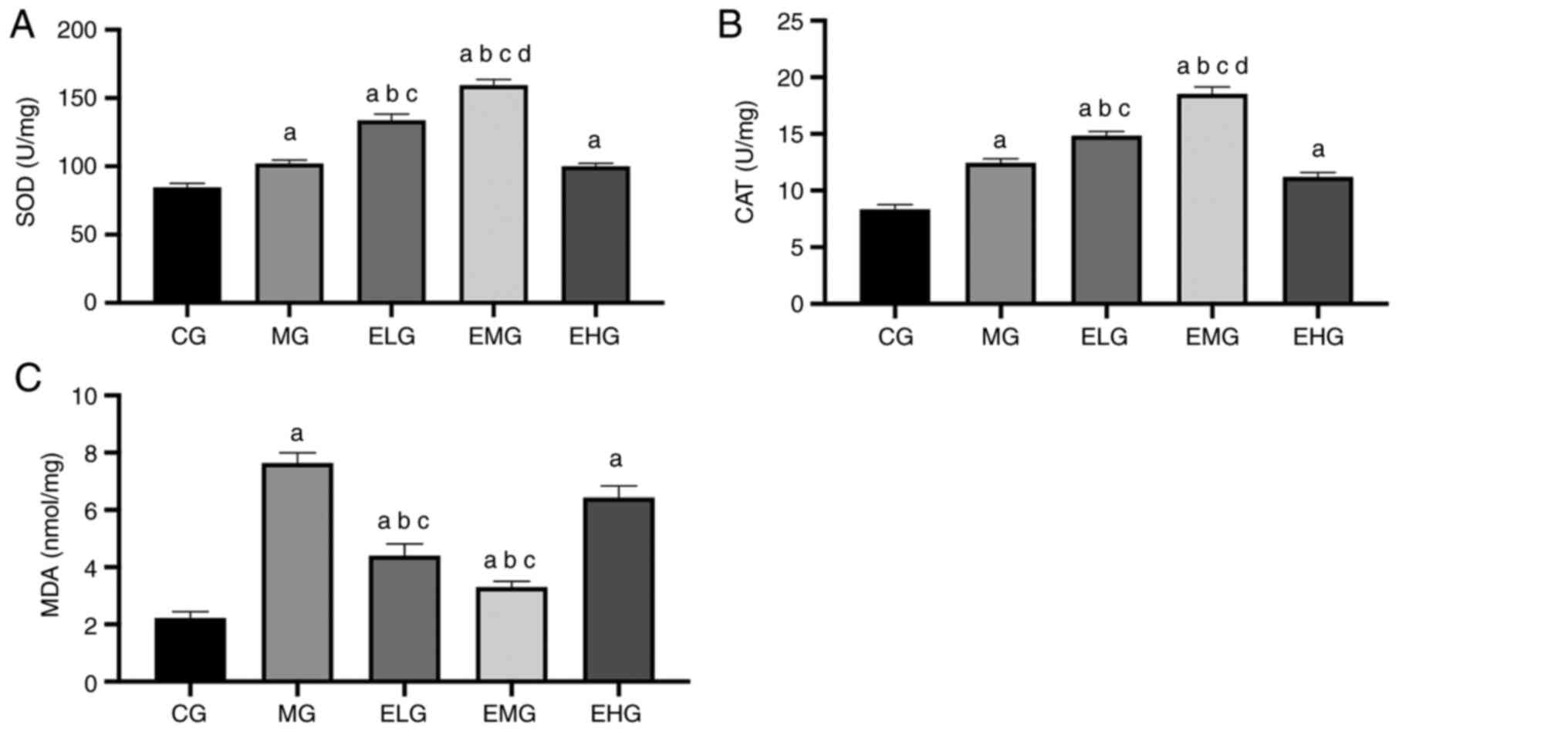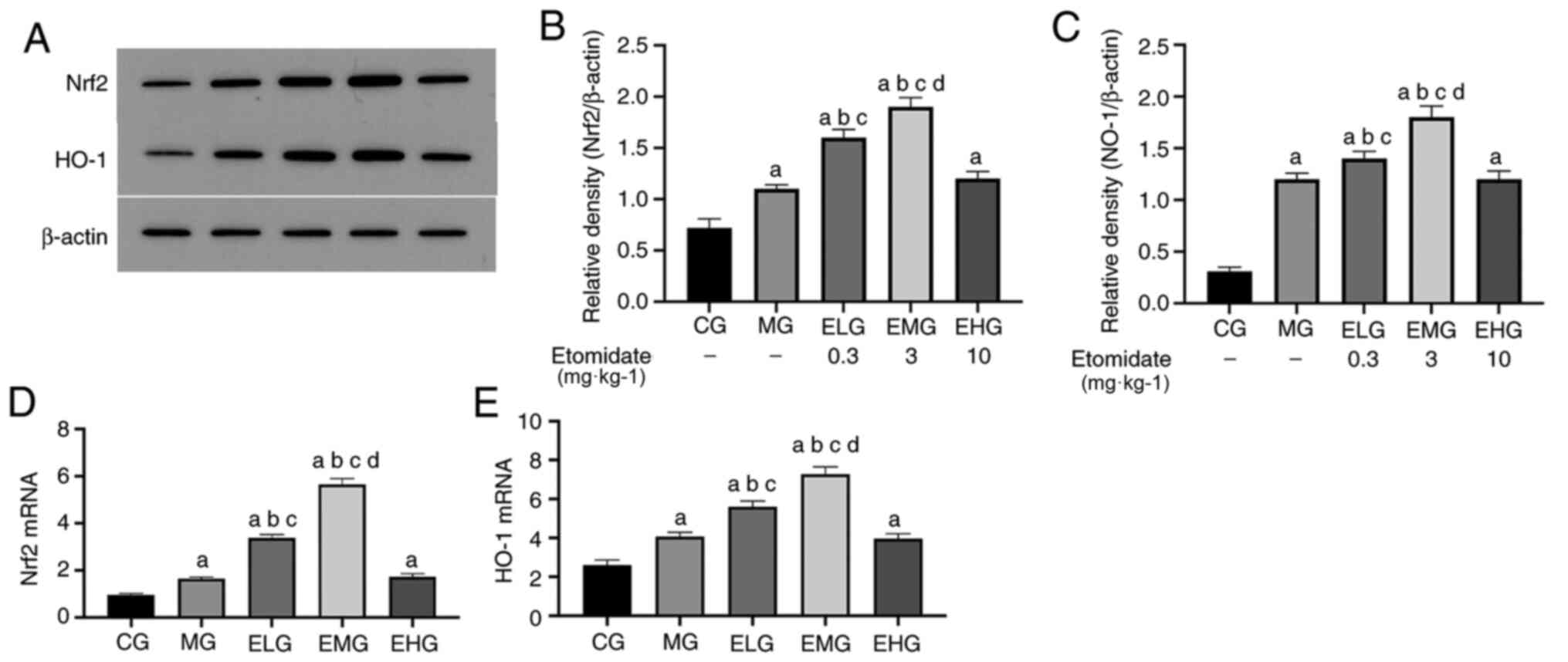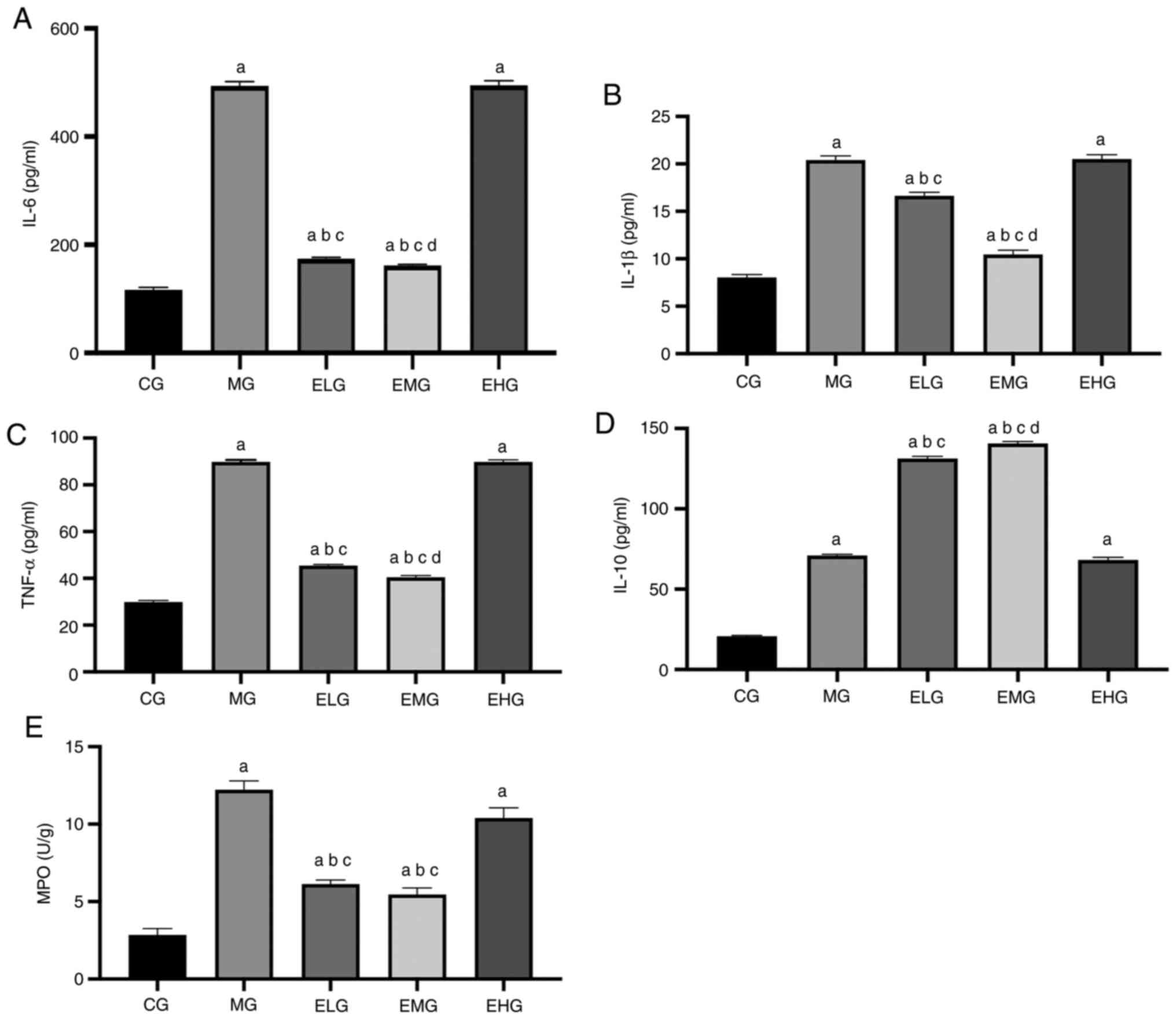|
1
|
Nyp MF, Mabry SM, Navarro A, Menden H,
Perez RE, Sampath V and Ekekezie II: Lung epithelial-specific
TRIP-1 overexpression maintains epithelial integrity during
hyperoxia exposure. Physiol Rep. 6(e13585)2018.PubMed/NCBI View Article : Google Scholar
|
|
2
|
Hovaguimian F, Lysakowski C, Elia N and
Tramèr MR: Effect of intraoperative high inspired oxygen fraction
on surgical site infection, postoperative nausea and vomiting, and
pulmonary function: Systematic review and meta-analysis of
randomized controlled trials. Anesthesiology. 119:303–316.
2013.PubMed/NCBI View Article : Google Scholar
|
|
3
|
Allegranzi B, Zayed B, Bischoff P, Kubilay
NZ, de Jonge S, de Vries F, Gomes SM, Gans S, Wallert ED, Wu X, et
al: New WHO recommendations on intraoperative and postoperative
measures for surgical site infection prevention: An evidence-based
global perspective. Lancet Infect Dis. 16:e288–e303.
2016.PubMed/NCBI View Article : Google Scholar
|
|
4
|
Edmark L, Kostova-Aherdan K, Enlund M and
Hedenstierna G: Optimal oxygen concentration during induction of
general anesthesia. Anesthesiology. 98:28–33. 2003.PubMed/NCBI View Article : Google Scholar
|
|
5
|
Ladha K, Vidal Melo MF, McLean DJ,
Wanderer JP, Grabitz SD, Kurth T and Eikermann M: Intraoperative
protective mechanical ventilation and risk of postoperative
respiratory complications: Hospital based registry study. BMJ.
351(h3646)2015.PubMed/NCBI View Article : Google Scholar
|
|
6
|
Li R, Fan L, Ma F, Cao Y, Gao J, Liu H and
Li Y: Effect of etomidate on the oxidative stress response and
levels of inflammatory factors from ischemia-reperfusion injury
after tibial fracture surgery. Exp Ther Med. 13:971–975.
2017.PubMed/NCBI View Article : Google Scholar
|
|
7
|
Xie D, Li M, Yu K, Lu H and Chen Y:
Etomidate alleviates cardiac dysfunction, fibrosis and oxidative
stress in rats with myocardial ischemic reperfusion injury. Ann
Transl Med. 8(1181)2020.PubMed/NCBI View Article : Google Scholar
|
|
8
|
Djuric M, Kostic S, Nikolic Turnic T,
Stankovic S, Skrbic R, Djuric DM, Zivkovic V, Jakovljevic V and
Stevanovic P: The comparison of the effects of ketamine and
etomidate on cardiodynamics, biochemical and oxidative stress
parameters in Wistar male rats. Mol Cell Biochem. 474:125–134.
2020.PubMed/NCBI View Article : Google Scholar
|
|
9
|
Zhao X, Kuang F, You YY, Wu MM and You SW:
Etomidate affects the anti-oxidant pathway to protect retinal
ganglion cells after optic nerve transection. Neural Regen Res.
14:2020–2024. 2019.PubMed/NCBI View Article : Google Scholar
|
|
10
|
Ates O, Yucel N, Cayli SR, Altinoz E,
Yologlu S, Kocak A, Cakir CO and Turkoz Y: Neuroprotective effect
of etomidate in the central nervous system of
streptozotocin-induced diabetic rats. Neurochem Res. 31:777–783.
2006.PubMed/NCBI View Article : Google Scholar
|
|
11
|
Cayli SR, Ates O, Karadag N, Altinoz E,
Yucel N, Yologlu S, Kocak A and Cakir CO: Neuroprotective effect of
etomidate on functional recovery in experimental spinal cord
injury. Int J Dev Neurosci. 24:233–239. 2006.PubMed/NCBI View Article : Google Scholar
|
|
12
|
Cho HY, Jedlicka AE, Reddy SP, Kensler TW,
Yamamoto M, Zhang LY and Kleeberger SR: Role of NRF2 in protection
against hyperoxic lung injury in mice. Am J Respir Cell Mol Biol.
26:175–182. 2002.PubMed/NCBI View Article : Google Scholar
|
|
13
|
Loboda A, Damulewicz M, Pyza E, Jozkowicz
A and Dulak J: Role of Nrf2/HO-1 system in development, oxidative
stress response and diseases: An evolutionarily conserved
mechanism. Cell Mol Life Sci. 73:3221–3247. 2016.PubMed/NCBI View Article : Google Scholar
|
|
14
|
Chen Z, Zhong H, Wei J, Lin S, Zong Z,
Gong F, Huang X, Sun J, Li P, Lin H, et al: Inhibition of Nrf2/HO-1
signaling leads to increased activation of the NLRP3 inflammasome
in osteoarthritis. Arthritis Res Ther. 21(300)2019.PubMed/NCBI View Article : Google Scholar
|
|
15
|
Abraham NG and Kappas A: Pharmacological
and clinical aspects of heme oxygenase. Pharmacol Rev. 60:79–127.
2008.PubMed/NCBI View Article : Google Scholar
|
|
16
|
Ohta S: Molecular hydrogen as a preventive
and therapeutic medical gas: Initiation, development and potential
of hydrogen medicine. Pharmacol Ther. 144:1–11. 2014.PubMed/NCBI View Article : Google Scholar
|
|
17
|
National Research Council (US): Committee
for the Update of the Guide for the Care and Use of Laboratory
Animals. Guide for the Care and Use of Laboratory Animals. 8th
edition. National Academies Press,Washington, DC, 2011.
|
|
18
|
Paris A, Hein L, Brede M, Brand PA, Scholz
J and Tonner PH: The anesthetic effects of etomidate:
Species-specific interaction with alpha 2-adrenoceptors. Anesth
Analg. 105:1644–1649. 2007.PubMed/NCBI View Article : Google Scholar
|
|
19
|
Patel V, Dial K, Wu J, Gauthier AG, Wu W,
Lin M, Espey MG, Thomas DD, Ashby CR Jr and Mantell LL: Dietary
antioxidants significantly attenuate hyperoxia-induced acute
inflammatory lung injury by enhancing macrophage function via
reducing the accumulation of airway HMGB1. Int J Mol Sci.
21(977)2020.PubMed/NCBI View Article : Google Scholar
|
|
20
|
Navidshad B, Liang JB and Jahromi MF:
Correlation coefficients between different methods of expressing
bacterial quantification using real time PCR. Int J Mol Sci.
13:2119–2132. 2012.PubMed/NCBI View Article : Google Scholar
|
|
21
|
Yu Q, Zhou Q, Huang H, Wang Y, Tian S and
Duan D: Protective effect of etomidate on spinal cord
ischemia-reperfusion injury induced by aortic occlusion in rabbits.
Ann Vasc Surg. 24:225–232. 2010.PubMed/NCBI View Article : Google Scholar
|
|
22
|
Nyman Y, Fredriksson A, Lönnqvist PA and
Viberg H: Etomidate exposure in early infant mice (P10) does not
induce apoptosis or affect behaviour. Acta Anaesthesiol Scand.
60:588–596. 2016.PubMed/NCBI View Article : Google Scholar
|
|
23
|
Besnier E, Clavier T, Tonon MC, Selim J,
Lefevre-Scelles A, Morin F, Tamion F, Dureuil B, Castel H and
Compere V: Ketamine and etomidate down-regulate the
hypothalamic-pituitary-adrenal axis in an endotoxemic mouse model.
Anesthesiology. 127:347–354. 2017.PubMed/NCBI View Article : Google Scholar
|
|
24
|
Benkwitz C, Liao M, Laster MJ, Sonner JM,
Eger EI II and Pearce RA: Determination of the EC50 amnesic
concentration of etomidate and its diffusion profile in brain
tissue: Implications for in vitro studies. Anesthesiology.
106:114–123. 2007.PubMed/NCBI View Article : Google Scholar
|
|
25
|
Green CJ, Knight J, Precious S and Simpkin
S: Metomidate, etomidate and fentanyl as injectable anaesthetic
agents in mice. Lab Anim. 15:171–175. 1981.PubMed/NCBI View Article : Google Scholar
|
|
26
|
Liao M, Sonner JM, Husain SS, Miller KW,
Jurd R, Rudolph U and Eger EI II: R (+) etomidate and the
photoactivable R (+) azietomidate have comparable anesthetic
activity in wild-type mice and comparably decreased activity in
mice with a N265M point mutation in the gamma-aminobutyric acid
receptor beta3 subunit. Anesth Analg. 101:131–135, table of
contents. 2005.PubMed/NCBI View Article : Google Scholar
|
|
27
|
Kallet RH and Matthay MA: Hyperoxic acute
lung injury. Respir Care. 58:123–141. 2013.PubMed/NCBI View Article : Google Scholar
|
|
28
|
Yuan CB, Tian L, Yang B and Zhou HY:
Isoalantolactone protects LPS-induced acute lung injury through
Nrf2 activation. Microb Pathog. 123:213–218. 2018.PubMed/NCBI View Article : Google Scholar
|
|
29
|
Rankin SM: The bone marrow: A site of
neutrophil clearance. J Leukoc Biol. 88:241–251. 2010.PubMed/NCBI View Article : Google Scholar
|
|
30
|
Ho YC, Lee SS, Yang ML, Huang-Liu R, Lee
CY, Li YC and Kuan YH: Zerumbone reduced the inflammatory response
of acute lung injury in endotoxin-treated mice via Akt-NFκB
pathway. Chem Biol Interact. 271:9–14. 2017.PubMed/NCBI View Article : Google Scholar :
Cannizzaro V,
Hantos Z, Sly PD and Zosky GR: Linking lung function and
inflammatory responses in ventilator-induced lung injury. Am J
Physiol Lung Cell Mol Physiol 300, L112-120, 2011.
|
|
31
|
Zhang Q, Wu D, Yang Y, Liu T and Liu H:
Dexmedetomidine alleviates hyperoxia-induced acute lung injury via
inhibiting NLRP3 inflammasome activation. Cell Physiol Biochem.
42:1907–1919. 2017.PubMed/NCBI View Article : Google Scholar
|
|
32
|
Li HD, Zhang QX, Mao Z, Xu XJ, Li NY and
Zhang H: Exogenous interleukin-10 attenuates hyperoxia-induced
acute lung injury in mice. Exp Physiol. 100:331–340.
2015.PubMed/NCBI View Article : Google Scholar
|
|
33
|
Li HD, Zhang ZR, Zhang QX, Qin ZC, He DM
and Chen JS: Treatment with exogenous hydrogen sulfide attenuates
hyperoxia-induced acute lung injury in mice. Eur J Appl Physiol.
113:1555–1563. 2013.PubMed/NCBI View Article : Google Scholar
|
|
34
|
Husari AW, Khayat A, Awdeh H, Hatoum H,
Nasser M, Mroueh SM, Zaatari G, El-Sabban M and Dbaibo GS:
Activated protein C attenuates acute lung injury and apoptosis in a
hyperoxic animal model. Shock. 33:467–472. 2010.PubMed/NCBI View Article : Google Scholar
|
|
35
|
Gong J, Liu H, Wu J, Qi H, Wu ZY, Shu HQ,
Li HB, Chen L, Wang YX, Li B, et al: Maresin 1 prevents
lipopolysaccharide-induced neutrophil survival and accelerates
resolution of acute lung injury. Shock. 44:371–380. 2015.PubMed/NCBI View Article : Google Scholar
|
|
36
|
Meng X, Hu L and Li W: Baicalin
ameliorates lipopolysaccharide-induced acute lung injury in mice by
suppressing oxidative stress and inflammation via the activation of
the Nrf2-mediated HO-1 signaling pathway. Naunyn Schmiedebergs Arch
Pharmacol. 392:1421–1433. 2019.PubMed/NCBI View Article : Google Scholar
|
|
37
|
Simonis FD, Juffermans NP and Schultz MJ:
Mechanical ventilation of the healthy lungs: Lessons learned from
recent trials. Curr Opin Crit Care. 27:55–59. 2021.PubMed/NCBI View Article : Google Scholar
|
|
38
|
Staehr-Rye AK, Meyhoff CS, Scheffenbichler
FT, Vidal Melo MF, Gätke MR, Walsh JL, Ladha KS, Grabitz SD,
Nikolov MI, Kurth T, et al: High intraoperative inspiratory oxygen
fraction and risk of major respiratory complications. Br J Anaesth.
119:140–149. 2017.PubMed/NCBI View Article : Google Scholar
|
|
39
|
Crapo JD: Oxidative stress as an initiator
of cytokine release and cell damage. Eur Respir J Suppl. 44:4s–6s.
2003.PubMed/NCBI View Article : Google Scholar
|
|
40
|
Zhang X, Shan P, Sasidhar M, Chupp GL,
Flavell RA, Choi AM and Lee PJ: Reactive oxygen species and
extracellular signal-regulated kinase 1/2 mitogen-activated protein
kinase mediate hyperoxia-induced cell death in lung epithelium. Am
J Respir Cell Mol Biol. 28:305–315. 2003.PubMed/NCBI View Article : Google Scholar
|
|
41
|
Schieber M and Chandel NS: ROS function in
redox signaling and oxidative stress. Curr Biol. 24:R453–R462.
2014.PubMed/NCBI View Article : Google Scholar
|
|
42
|
Wiegman CH, Li F, Clarke CJ, Jazrawi E,
Kirkham P, Barnes PJ, Adcock IM and Chung KF: A comprehensive
analysis of oxidative stress in the ozone-induced lung inflammation
mouse model. Clin Sci (Lond). 126:425–440. 2014.PubMed/NCBI View Article : Google Scholar
|
|
43
|
Villegas L, Stidham T and Nozik-Grayck E:
Oxidative stress and therapeutic development in lung diseases. J
Pulm Respir Med. 4(194)2014.PubMed/NCBI View Article : Google Scholar
|
|
44
|
Gore A, Muralidhar M, Espey MG, Degenhardt
K and Mantell LL: Hyperoxia sensing: From molecular mechanisms to
significance in disease. J Immunotoxicol. 7:239–254.
2010.PubMed/NCBI View Article : Google Scholar
|
|
45
|
Pagano A and Barazzone-Argiroffo C:
Alveolar cell death in hyperoxia-induced lung injury. Ann NY Acad
Sci. 1010:405–416. 2003.PubMed/NCBI View Article : Google Scholar
|
|
46
|
Christ M, Luu B, Mejia JE, Moosbrugger I
and Bischoff P: Apoptosis induced by oxysterols in murine lymphoma
cells and in normal thymocytes. Immunology. 78:455–460.
1993.PubMed/NCBI
|
|
47
|
Yamamoto H, Yamamoto Y, Yamagami K, Kume
M, Kimoto S, Toyokuni S, Uchida K, Fukumoto M and Yamaoka Y:
Heat-shock preconditioning reduces oxidative protein denaturation
and ameliorates liver injury by carbon tetrachloride in rats. Res
Exp Med (Berl). 199:309–318. 2000.PubMed/NCBI View Article : Google Scholar
|
|
48
|
Zhao X, Jin L, Shen N, Xu B, Zhang W, Zhu
H and Luo Z: Salidroside inhibits endogenous hydrogen peroxide
induced cytotoxicity of endothelial cells. Biol Pharm Bull.
36:1773–1778. 2013.PubMed/NCBI View Article : Google Scholar
|
|
49
|
Sun Q, Wu Y, Zhao F and Wang J: Maresin 1
ameliorates lung ischemia/reperfusion injury by suppressing
oxidative stress via activation of the Nrf-2-Mediated HO-1
signaling pathway. Oxid Med Cell Longev.
2017(9634803)2017.PubMed/NCBI View Article : Google Scholar
|
|
50
|
Cho HY, Jedlicka AE, Reddy SP, Zhang LY,
Kensler TW and Kleeberger SR: Linkage analysis of susceptibility to
hyperoxia. Nrf2 is a candidate gene. Am J Respir Cell Mol Biol.
26:42–51. 2002.PubMed/NCBI View Article : Google Scholar
|
|
51
|
Kuo PC, Yu IC, Scofield BA, Brown DA,
Curfman ET, Paraiso HC, Chang FL and Yen JH:
3H-1,2-Dithiole-3-thione as a novel therapeutic agent for the
treatment of ischemic stroke through Nrf2 defense pathway. Brain
Behav Immun. 62:180–192. 2017.PubMed/NCBI View Article : Google Scholar
|
|
52
|
Jung KA and Kwak MK: The Nrf2 system as a
potential target for the development of indirect antioxidants.
Molecules. 15:7266–7291. 2010.PubMed/NCBI View Article : Google Scholar
|
|
53
|
Chan K and Kan YW: Nrf2 is essential for
protection against acute pulmonary injury in mice. Proc Natl Acad
Sci USA. 96:12731–12736. 1999.PubMed/NCBI View Article : Google Scholar
|
|
54
|
Iizuka T, Ishii Y, Itoh K, Kiwamoto T,
Kimura T, Matsuno Y, Morishima Y, Hegab AE, Homma S, Nomura A, et
al: Nrf2-deficient mice are highly susceptible to cigarette
smoke-induced emphysema. Genes Cells. 10:1113–1125. 2005.PubMed/NCBI View Article : Google Scholar
|
|
55
|
Cho HY and Kleeberger SR: Noblesse oblige:
NRF2 functions in the airways. Am J Respir Cell Mol Biol.
50:844–847. 2014.PubMed/NCBI View Article : Google Scholar
|
|
56
|
Hirotsu Y, Katsuoka F, Funayama R,
Nagashima T, Nishida Y, Nakayama K, Engel JD and Yamamoto M:
Nrf2-MafG heterodimers contribute globally to antioxidant and
metabolic networks. Nucleic Acids Res. 40:10228–10239.
2012.PubMed/NCBI View Article : Google Scholar
|
|
57
|
Murakami A, Tanaka T, Lee JY, Surh YJ, Kim
HW, Kawabata K, Nakamura Y, Jiwajinda S and Ohigashi H: Zerumbone,
a sesquiterpene in subtropical ginger, suppresses skin tumor
initiation and promotion stages in ICR mice. Int J Cancer.
110:481–490. 2004.PubMed/NCBI View Article : Google Scholar
|
|
58
|
Willis D, Moore AR and Willoughby DA: Heme
oxygenase isoform expression in cellular and antibody-mediated
models of acute inflammation in the rat. J Pathol. 190:627–634.
2000.PubMed/NCBI View Article : Google Scholar
|
|
59
|
Li QF, Zhu YS, Jiang H, Xu H and Sun Y:
Heme oxygenase-1 mediates the anti-inflammatory effect of
isoflurane preconditioning in LPS-stimulated macrophages. Acta
Pharmacol Sin. 30:228–234. 2009.PubMed/NCBI View Article : Google Scholar
|
|
60
|
Amata E, Pittalà V, Marrazzo A, Parenti C,
Prezzavento O, Arena E, Nabavi SM and Salerno L: Role of the
Nrf2/HO-1 axis in bronchopulmonary dysplasia and hyperoxic lung
injuries. Clin Sci (Lond). 131:1701–1712. 2017.PubMed/NCBI View Article : Google Scholar
|
|
61
|
Hausburg MA, Banton KL, Roman PE, Salgado
F, Baek P, Waxman MJ, Tanner A II, Yoder J and Bar-Or D: Effects of
propofol on ischemia-reperfusion and traumatic brain injury. J Crit
Care. 56:281–287. 2020.PubMed/NCBI View Article : Google Scholar
|
|
62
|
Bell MT, Puskas F, Bennett DT, Herson PS,
Quillinan N, Fullerton DA and Reece TB: Dexmedetomidine, an α-2a
adrenergic agonist, promotes ischemic tolerance in a murine model
of spinal cord ischemia-reperfusion. J Thorac Cardiovasc Surg.
147:500–506. 2014.PubMed/NCBI View Article : Google Scholar
|
|
63
|
Araújo MN, Santos CL, Samary CS, Heil LB,
Cavalcanti VC, Cruz FF, Felix NS, Silva JD, Morales MM, Pelosi P,
et al: Sevoflurane, compared with isoflurane, minimizes lung damage
in pulmonary but not in extrapulmonary acute respiratory distress
syndrome in rats. Anesth Analg. 125:491–498. 2017.PubMed/NCBI View Article : Google Scholar
|
|
64
|
Zhang Y, Du H, Yu X and Zhu J: Fucoidan
attenuates hyperoxia-induced lung injury in newborn rats by
mediating lung fibroblasts differentiate into myofibroblasts. Ann
Transl Med. 8(1501)2020.PubMed/NCBI View Article : Google Scholar
|
|
65
|
Tayman C, Cekmez F, Kafa IM, Canpolat FE,
Cetinkaya M, Tonbul A, Uysal S, Tunc T and Sarici SU: Protective
effects of nigella sativa oil in hyperoxia-induced lung injury.
Arch Bronconeumol. 49:15–21. 2013.PubMed/NCBI View Article : Google Scholar : (In Spanish).
|
|
66
|
Zhang Q, Wu D, Yang Y, Liu T and Liu H:
Effects of dexmedetomidine on the protection of hyperoxia-induced
lung injury in newborn rats. Int J Clin Exp Pathol. 8:6466–6473.
2015.PubMed/NCBI
|















